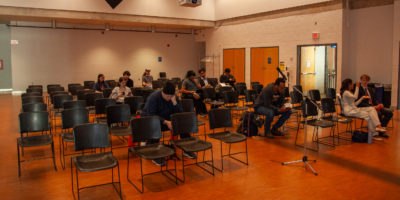By Ashley Pergolas
Two men, overcome by a rush of adrenalin and testosterone begin duking it out. The fight, triggered by something mundane is overtaken by primal instinct. One man is shoved against a chain-link fence, his body straining against the pain. His opponent knees him in the stomach once, twice, three times. He feels nauseated but manages to throw a punch straight to his opponent’s head, hard enough to send him crashing to the ground.
But, this isn’t a street fight that has broken out in front of a bar, outside of a club or in the deserted streets of a rundown part of town. These men are voluntarily standing in the middle of a ring where the street lights are replaced with intense spotlights and the echoes ringing through the empty air are traded for the cries of cheering fans.
This is the world of Mixed Martial Arts — street fighting in a ring; bare-knuckle fighting with no-holds-barred. The phenomenon of ultimate fighting began in Japan and hit North America in the 1990s. It’s man versus man in this world and the only way to escape is to submit.
MMA combines an array of fighting techniques from a variety of disciplines that include boxing, wrestling, kick-boxing, jiu-jitsu, judo and karate. In a ring with two contestants who have trained in deadly hand-to-hand combat styles, it’s tap-out or pass-out.
Ultimate fighting is a fast-growing sport rapidly gaining recognition in Canada. But in Ontario, the path toward acceptance has come to a grinding halt. MMA fans in Ontario have seen the blows, have seen the blood and have seen the skills, but now they want more — they want to see the action live. These events are illegal in Ontario but fans can find it in Quebec, just moments away from Ottawa.
Section 83 of the Ontario Criminal Code says that prizefighting — any match that is fought for money — is illegal, and MMA is considered to be just that. The kicker is that Quebec has the same law, and yet MMA events are being held in Quebec and not in Ontario.
Provincial athletic commissions are the bodies that regulate and sanction combat sports. Quebec’s abundant history of sanctioning sports such as boxing and kick-boxing cleared the way for allowing ultimate fighting events. However, Ontario athletic commissioner, Ken Hayashi, doesn’t see it as being that simple for Ontario.
“To permit and regulate professional MMA events, amendments to the Athletic Control Act would be required,” he says — something which could take years of cutting through red tape.
Joe Ferraro, CEO of Showdown Entertainment, has spent the last six years trying to get MMA legalized in Ontario. Showdown Entertainment specializes in the Canadian ultimate fighting scene and its founder is a leading figure in the movement to legalize MMA events in Ontario — earning him the nickname “Showdown Joe.”
Ferraro has been approaching the athletic commissioner on a semi-regular basis regarding the sanctioning of MMA events in Ontario.
“All he has to say is ‘not interested’ or ‘no thanks’ and there is not much anyone can do about it,” Ferraro says.
A fan of MMA for 13 years, Ferraro has been working with the Ministry of Health to get ultimate fighting recognized as an amateur sport, which Ferraro feels is the first step towards legalizing MMA across Ontario.
“I really believe that there’s an amateur circuit similar to boxing that will eventually breed champions on a professional level,” he says, dreaming of the day that MMA will be legal in Ontario — a day that Ferraro strongly believes will come once Hayashi retires.
Hayashi also believes that the amateur circuit is exactly where MMA promoters should start. “Promoters of MMA events should first explore getting their sport sanctioned through the amateur process by contacting the Ministry of Health Promotions’ sports and recreation branch,” he says.
Hayashi explains this will be the first step towards establishing a safety track record in Ontario, as well as a framework for regulating the event safely. But there are those involved with the sport that believe MMA has already proven that it is safe for competitors.
Rob MacDonald, 28, has been training as an MMA fighter for 15 years, and has been competing for the last five. In 2005, MacDonald was a contestant on a reality show called the Ultimate Fighter, which searched for the best unknown contender to receive a lucrative contract. As a Toronto resident, he would like to see the fights come to his city.
He urges those who only see MMA as prize fighting to, “look behind the scenes and see the dedication that goes into it and the mutual respect that fighters have for each other. They would see that it is every bit a valued sport as anything else.”
Rob Balsdon, a hardcore fan of MMA, has followed the sport for the past 14 years. “It’s far and away the most entertaining sport anyone can watch,” he says. “It’s competition in its rawest form.”
However, the idea of two people fighting bare-fisted in a ring, using strategic choke holds and submission techniques is just too violent for some people to digest.
“My mom grounded me when she found out I ordered the first UFC fight on pay-per-view,” Balsdon recalls. “I was only 13.” Balsdon even got into trouble while working at Rogers Video for playing MMA footage in the store.
While MMA has been gaining recognition in the United States since the 1993 establishment of the Ultimate Fighting Championship in Denver, Col., Canada has been somewhat sheltered from the growing spectacle of these events. However, Canadians have found a way to get their raw brutality fix through the Internet, pay-per-view programs and the Fight Network. Interest is growing rapidly, leaving fans craving more blood, more sweat and more pure athletic prowess.
Balsdon normally pays $40 for fights that are on pay-per-view. For him, fight night has become just as popular as Hockey Night in Canada or watching football on Sundays. In Balsdon’s downtown apartment at Sherbourne and Dundas streets, fight night has finally arrived and the bets are in.
A whiteboard in the living room lists tonight’s fights and the odds. The testosterone in the room is overwhelming — which probably explains why the balcony door is left open. The single couch facing the television is packed with five people, and all the other seats in the room are taken. Balsdon opened the two-four of Canadian about an hour ago, optimistic that the late arrivals would be bringing more beer.
The poker table on the landing beside the living room is set up for the couple of girlfriends tagging along and the other guests that aren’t that interested in the fight. The hardcore fans hover around the television waiting for the action to begin. Then, the announcer shouts… “Let’s get it on!”
The cheering and sympathy groans hit a new high when one contestant performs a technique called an “arm bar” — an effective joint lock that causes a great deal of pain, judging from the other contestant’s face.
One of the guys watching the fight lets out an enthusiastic, “oh!” and claps his hands in admiration. The struggle on the screen continues until both men are back on their feet. The room grumbles at the momentary loss of action. Then comes the blow that causes some of the Balsdon’s guests to wince while the others jump up and cheer.
One man throws a punch directly into his opponent’s face, sending him wobbling backwards for a few steps and then crashing down to the ground. The referee ends the fight, deciding that the man on the ground can no longer defend himself.
The contestants send each other cold stares and the man who was punched in the face is bleeding from his forehead —the blood trickles down the side of his face. He doesn’t seem to notice.
Paying $40 to pay to see the events on pay-per-view is nothing compared to what some fans would pay to see a live MMA fight in a city outside of Ontario. Ferraro continues to work with the Ministry of Health and other parties in an attempt to convince the Athletic Commissioner that the Ontario market — particularly Toronto —would benefit greatly from hosting MMA events.
Taking into consideration ticket prices, hotel rates, restaurants and gas prices, Ferraro estimates that a single MMA event could bring in anywhere from $400,000 to $600,000. As long as MMA remains unsanctioned in the province, Ferraro and the rest of Ontario’s ultimate fighting fans will have to travel to cities like Montreal to witness the action live.
So why not sanction MMA? Hayashi says that there is no way of regulating it as a sport without guidelines from the provincial government that stay within the framework of the Criminal Code.
“MMA is distinguishable from boxing contests and kick-boxing because it involves striking with the elbows and knees, grappling, throws, striking the opponent on the ground and open-hand gloves,” Hayashi explains.
These are all techniques that are illegal in a regulated fighting match. Despite the pressure from promoters and fans, the debate continues that ultimate fighting is only a barbaric display of brute strength — nothing more than prizefighting.
As the province anticipates MMA’s legalization, Ferraro continues to do all he can to help it gain recognition as a valuable sport.
“It’s like circling a track,” Ferraro says, “You’re running but you’re not getting anywhere.”
Not discouraged by the continuous dismissal of the idea that MMA be sanctioned, Ferraro is more than confident that fans in Ontario will soon be able to witness the action in their own province. “I knew from day one that MMA was going to have a bright future and that’s why I’m still in it.”
“Toronto is a world-class city,” MacDonald explains, “its got world-class operas and shows; its got an NHL team; its got a NBA team; its got a major league baseball team — MMA is just the next step.”









Leave a Reply